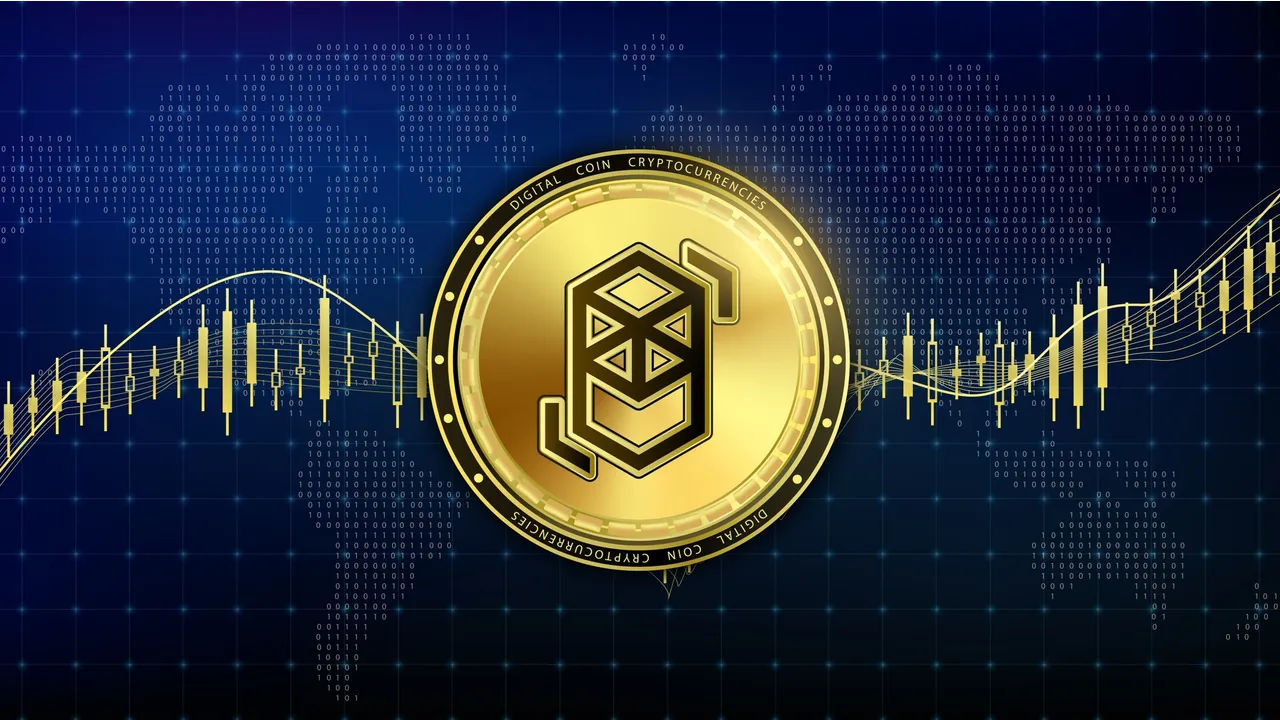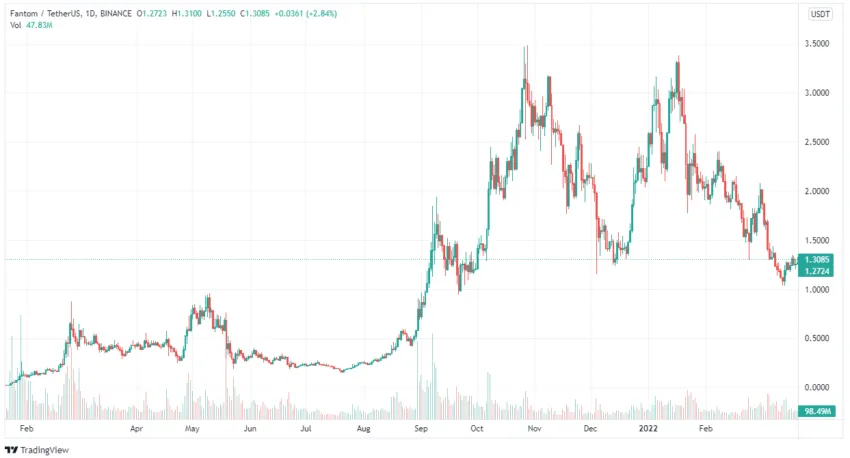In response to the glaring limitations of the Ethereum network, a lot of projects have been erupting to fill these problems. Among these projects is Fantom, which aims to solve the ‘trilemma’ issue between scalability, security, and decentralization within a blockchain network.
Fantom is essentially a highly scalable, secure, and EVM-compactibility smart contract platform that utilizes a single consensus mechanism to offer the integration of several DApps. FTM — the network’s token is used for governance, staking, and paying fees for deploying apps in the blockchain.
In this guide:
- What is Fantom?
- The evolution of Fantom (FTM)
- FTM token history
- How does Fantom (FTM) work?
- Fantom DeFi
- Fantom vs. competitors
- Roadmap and development history
- Tokenomics
- Token usage
- Market capitalization
- Governance
- Price and price predictions
- How to buy FTM?
- How to stake FTM
- The bigger picture
- Frequently asked questions
What is Fantom?
Fantom is a layer 1 distributed ledger that offers seamless deployment of smart contracts on its network. The platform uses an advanced DAG — Directed Acyclic Graph, which involves seamless interaction of computer nodes in a network to ensure fast and secure transactions. (DAG) smart contract platform was designed to outstrip the problems of the previous wave of blockchain platforms.
Fantom uses a distinct Proof-of-Stake (PoS) model, which is an independent layer called the “Lachesis Protocol” to achieve consensus. The goal of this protocol is to be integrated into the EVM-compatible smart contract chain called the Fantom Opera chain. Essentially, it allows several projects to be built on the Fantom Opera chain to enjoy the basic functionalities of Fantom. This includes swift transactions and minimal transaction costs for all users while maintaining effective security.
Lachesis works like the regular PoS platform, but this technology is faster and much more cost-effective. It combines different time periods and executes them on a single vote. This method facilitates the high transaction process by processing 4500 transactions per second, including basic transactions and smart contracts.
/Related
MORE ARTICLESBest Christmas Crypto Promotions in 2022
Top 10 Telegram Channels for Crypto Signals in 2022
9 Best Crypto Exchanges for Beginners
Copy Trading: A Definitive Guide for Beginners (2022)
What Is the Crypto Fear and Greed Index?
Top 7 Crypto Debit Cards in Europe
How To Make Money With Bitcoin in 2022: 9 Proven Methods
Web3 Jobs: How to Get a Job in Crypto Sector
Who Owns the Most Bitcoin in 2022?
Fantom is posing to be a reliable alternative to Bitcoin, whose transactions process can take up to an hour, and Ethereum, which can take up to 10 minutes. Fantom network only takes about 1–2 seconds to process while aiming for 300,000 transactions per second.
The project’s long-term goal is to offer compatibility within wider transaction bodies across the globe using fast DAG technology that can be integrated at a larger scale in the real world. Also, it is looking to design a new sustainable infrastructure with permits for real-time transactions and data transfer.
The evolution of Fantom (FTM)
After putting much research and planning into building an ecosystem for months, Fantom was officially launched in Jan. 2018. This was done by a team called Fantom foundation.
Fantom Foundation seeks to develop the ecosystem for a more decentralized, transparent, and adept future. The group comprises engineers, scientists, researchers, designers, and entrepreneurs who share the same goal.
According to its whitepaper, Lachesis consensus protocol (or Lachesis protocol) and a directed acyclic graph (DAG) put Fantom to work. These two help the network attain a Byzantine fault tolerance asynchronous (aBFT).
The Fantom network is consistently building multiple disturbed layers on Lachesis.
In Dec. 2019, the project built its first layer, Opera Chain, which involves compatibility with the Ethereum Virtual Machine smart contract. Making FTM available as an ERC-20 token standard.
Opera chain is a dependent PoS layer that relies on Lachesis to confirm transactions and generate new blocks within the network. It supports Curve, CREAM, and other popular decentralized finance (DeFi) applications.
In the second quarter of 2019, Fantom built quite a special place in the hearts of many when it announced integration into Binance Chain. FTM is available on Binance Chain tokens as BEP-2.
This means the Binance Chain handles transactions on this network. The integration of Fantom into the Ethereum and Binance Chain gives room for an overall improved interoperable ecosystem.
In Sept. 2021, Andre Conje, a founding member, launched NFT marketplace on Fantom network.
FTM token history
In the last quarter of 2018, the platform launched its innate currency, FTM, which started trading at around $0.02. At this time, it launched an initial coin offering (ICO) that amounted to $40 million. This was then used in funding the project.
Since then, the FTM price has experienced massive growth simultaneous to the steady development of the whole project. It reached an all-time high of $3.48 in Dec 2021, and it’s currently trading at $1.23.
How does Fantom (FTM) work?

As explained earlier, basically, Fantom has two technologies backing it, which are DAG and Lachesis. DAG allows swift validation of transactions while Lachesis provides security to the multiple chains deployed within the ecosystem.
Lachesis does a lot of work in the ecosystem, and it has been broken down for easier explanation.
Lachesis uses an Asynchronous Byzantine Fault Tolerant (aBFT) to attain high-performance data storage
To better understand this, let’s use a group of the marketing team in a company as an example. There are four marketing team leaders. Each leader has their members. These four have the same goals to launch a successful campaign for the company.
To plan a strategy on outperforming their competitor, they need to send each member to the other company. Still, the issue regarding this strategy is that members could be lured by a more attractive salary, thereby compromising the whole campaign.
One or two of these team leaders can also decide to change their minds at any point in time, thereby disrupting the whole strategy. How can you successfully execute this campaign to win the campaign without any compromise?
This example depicts a decentralized network or blockchain, with each team leader representing a node in the network.
Decentralization gives room for complete freedom, which can make people disobey the laid down rules. How can you ensure a stabilized network and ensure all the nodes reach a fair consensus (agreement)? This is what Byzantine Fault Tolerance solves.
Byzantine Fault Tolerance ensures a trustless and transparent network, even with potential malicious acts. The network nodes agree on the timing and process of transactions as well as block production.
However, with Asynchronous Byzantine Fault Tolerance (aBFT), users are free to process orders at different times. It is an improved version of Byzantine Fault Tolerance (BFT) that enables a decentralized, trustless network.
Byzantine Fault Tolerance enables the network to come to a fair consensus, even if up to 1/3 of nodes decide to hinder that agreement, perhaps by delaying transactions.
Asynchronous Byzantine Fault Tolerance (aBFT) improves BFT by removing the time limit on delayed messages and allowing them to be lost completely.
Lachesis as a Proof-of-Stake (PoS) protocol to secure the entire network
Fantom has employed Lachesis as a consensus layer that can extend to multiple layers within the system. Transactions are confirmed in 1–2 seconds. It’s a highly scalable protocol that ensures fast and high security on the Fantom network.
Lachesis powers “Opera,” Fantom’s mainnet blockchain platform
Unlike the typical PoS models, where validators have the final say on the confirmation of transactions, the opera mainnet is absolutely leaderless, thereby enabling users to play a unique role in producing blocks. Generally, taking off leaders massively boosts network security.
On the Opera chain, any network user can become a validator by running their node. Validating nodes helps with the security of the network. Also, FTM holders can become a delegator by holding as low as 1 FTM.
Fantom DeFi
Fantom has solid support for the Defi ecosystem.
On the network, you can access its Defi offerings and trade directly from your wallet. Below is a definition of the common terms used within the platform.
- fWallet: A fantom wallet that allows you to deposit and store FTM
- fUSD: a Fantom-based stablecoin, you can trade, lend, and borrow with this on fLend. You can also mint fUSD with fMint.
- fLend: a liquidity pool that allows users to lend or borrow
- fSwap: a decentralized asset trading platform that allows users to swap between different tokens
Fantom vs. competitors

Fantom appears to stand out alongside its other competitors. Ethereum, Solana, and Cardano are big competitors to Fantom. Distinctively, these projects offer improved scalability and effective transaction fees to blockchain networks.
Some crypto professionals have touted Fantom to be the next Ethereum or Solana. And the main difference between Fantom and these other projects is that Fantom creates an entirely new blockchain for each deployed smart contract, while others don’t.
This massively boosts interoperability, thereby reducing the workload in the network. This also fosters scalability as these blockchains act differently within the network. They are, however, connected using the same consensus algorithm.
Let’s compare these networks based on transaction speed and time.
- Transaction per second: Most times, the values indicated by the blockchain’s website are not always the realistic tps values. For example, Solana claims about 50,000 tps but only processes up to about 300 tps. Cardano processes about 260 tps, while Polkadot records around 170 tps. The practical value for Fantom is around 11 tps.
- Block time: Fantom has a practical block time of 1 sec, Polkadot has 6 seconds while it takes 20 secs for Cardano to generate new blocks. Solana is undoubtedly the fastest here, with 0.6 seconds.
Roadmap and development history
In line with the whitepaper, the platform features five different milestones, which include the Intermezzo stage, Seria stage, Buffa stage, Opera Stage, and grand Opera stage.
The below diagram should give a broader overview of the roadmap milestones.
A quick summary of the development history includes:
The release of the testnet in late 2019. This testnet was majorly for developers, which is available on the network’s GitHub page.
The second major launch was the release of Opera mainnet in Dec. 2019. The network supported EVM and Solidity smart contract features. And has since been running on the Lachesis consensus mechanism.
Tokenomics

There are nearly 3.2 billion FTM tokens in circulation. The project adopts an inflationary model to grow the ecosystem. Fantom was ready for the initial 5% annual inflation rate that reduces as more users join the platform.
The platform uses 20% of the total inflation reward nodes, and gives the rest as incentives for Fantom network users. These incentives include negligible transaction fees, and rewards for users for contributing to the overall growth of the network.
FTM tokens were distributed in the following way:
- 40% token sale
- 30% market development
- 15% advisors / contributors
- 15% FANTOM team and founders
Token usage
In summary, FTM token can be use for:
- Payments and transactions fees within the network
- Securing the network through staking
- Governance: voting within the on-chain governance structure.
The platform requires validators to stake FTM to run a node and receive an equal fraction of staking rewards. However, users who are unable to validate a node can delegate their tokens to an existing validator to earn a fraction of their staking rewards and network fees.
Notably, voting power is determined by the staking amount of a validator with the delegations received.
Market capitalization
The total value locked (TVL) in the Fantom network is over $6 billion. It has a total market capitalization of about $3.8 billion, and it’s currently trading at $1.21.
Governance
Unlike other platforms that use a direct yes or no voting method, Fantom is quite different with this approach. It allows you to vote on a scale of 1 to 4 how much you want a new proposal to be implemented. As a result, for the proposal to be adopted, it must have at least 66% of the voting power.
Price and price predictions
 FTM price: TradingView
FTM price: TradingView
The price of FTM tokens has been dumping since attaining a high of nearly $3.41 in early Jan. Since then, it has reached a low of $1.07 in mid-Mar. This resulted in a new yearly low after the notable low experienced in late 2021 at $1.14.
Will the price rise sooner than expected? Let’s take a look at what professional crypto analysts predict the price of FTM to be for 2022.
A certain analyst has a 2022 price prediction of $3.79, which depicts an increase of 51%. In the best-case scenario, some crypto analysts believe FTM price could pump as high as $4.28 during 2022.
Notably, price predictions are always based on technical analysis, analysis for factors such as market cap, volume, and historical prices. It is important you do your personal research before considering buying any token.
How to buy FTM?
You can buy FTM on decentralized exchanges:
Opening an account on Binance is easy, and you can typically buy within a few hours after registering.
Once you have uploaded the required credentials, such as a your passport, you can proceed to fund your account and choose the best currency pair to buy.
For clarity, here’s a step-by-step guide.
- Once you have completed the registration, enter your details and login
- Buy USDT
You can now deposit USDT by sending the coin to your specified USDT wallet.
- Buy FTM
Once you have completed the deposit, you’ll need to choose FTM/USDT and enter the amount of FTM you want to purchase.
How to stake FTM
You can stake FTM on the Fantom Wallet. It’s also available via some crypto wallets and exchanges.
The easiest method is to use the fantom wallet by selecting Staking on the left-hand side of the screen and then choosing Add delegation.
Below is a step-by-step guide on how to stake FTM
- Input the amount of FTM you are willing to stake. You can start with 1 FTM and start earning rewards.
- Select the three-line menu and choose a Validator you’re willing to delegate with.
You can click on their name to explore more about a particular validator.
- Now it’s time for you to review your options — amount and validator, and then click Continue.
- Enter your details, and click Delegate. After confirmation, click Continue.
Delegation successful!
Note: You can explore the best-performing strategy to earn about 3% APR or lock your FTM tokens for a longer period of time. The longer you lock up your tokens, the higher you earn.
- To lock your tokens, click Lock Delegation, choose the number of days you would like, and click Ok.
The bigger picture
Fantom using Lachesis, an innovative aBFT consensus, has been able to create a whole stack of blockchain ecosystems.
Many new innovations are still upcoming. The platform aims to build the network for a more interoperable and efficient future where there would be real-world use cases to improve the quality of their lives.
If you’ve not exceeded your investment plan, you might include it as a long-term investment in your portfolio. However, it’s important you do a personal research before buying any asset.





